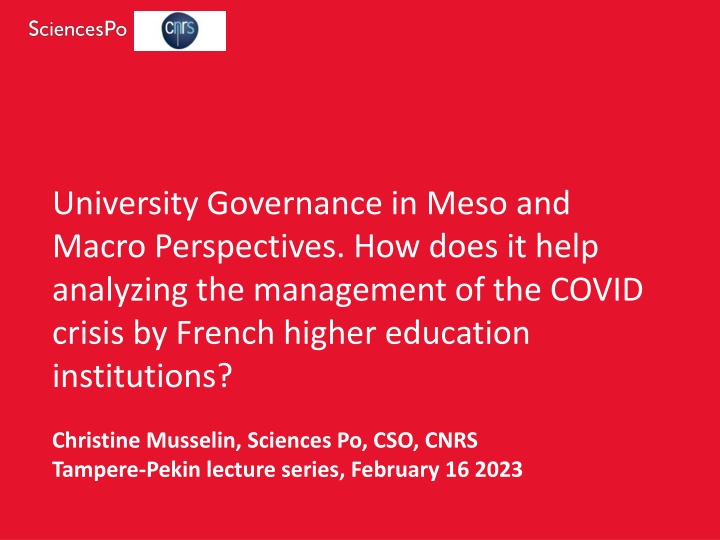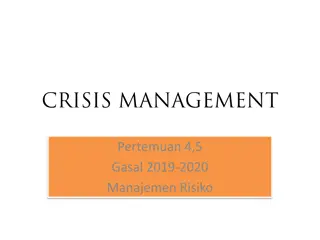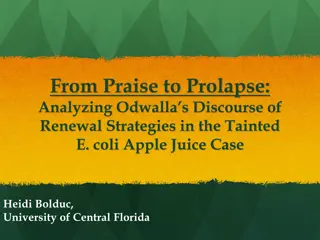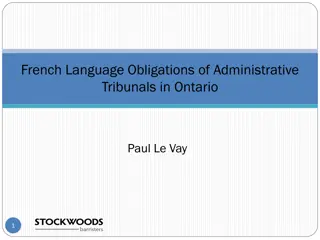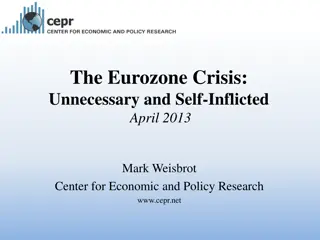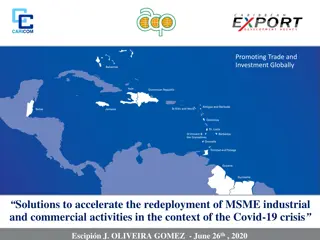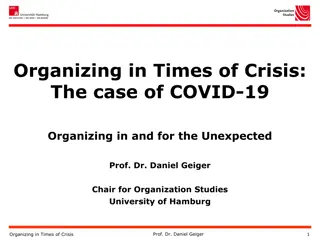Analyzing the Management of the COVID Crisis by French Higher Education Institutions
The talk explores how university governance perspectives help in analyzing the management of the COVID crisis by French higher education institutions. Christine Musselin from Sciences Po presents insights from a study conducted in France, highlighting the relevance of university governance in crisis management. The discussion delves into empirical research, different meanings of university governance, and the responses to the crisis at both organizational and system levels.
Download Presentation

Please find below an Image/Link to download the presentation.
The content on the website is provided AS IS for your information and personal use only. It may not be sold, licensed, or shared on other websites without obtaining consent from the author.If you encounter any issues during the download, it is possible that the publisher has removed the file from their server.
You are allowed to download the files provided on this website for personal or commercial use, subject to the condition that they are used lawfully. All files are the property of their respective owners.
The content on the website is provided AS IS for your information and personal use only. It may not be sold, licensed, or shared on other websites without obtaining consent from the author.
E N D
Presentation Transcript
University Governance in Meso and Macro Perspectives. How does it help analyzing the management of the COVID crisis by French higher education institutions? Christine Musselin, Sciences Po, CSO, CNRS Tampere-Pekin lecture series, February 16 2023
Objectives of this talk : To build on the literature review I led for the paper published in the Annual Review of Sociology on University governance and To show the relevance of the notion of university governance by applying it to the results of a study led in France on the management of the Covid crisis by French higher education institutions A study led with two colleagues : St phanie Mignot-G rard (UPEC) and Aline Waltzing (Adoc-Metis) A study funded by the French research council (ANR) from September 2020 to March 2022. 2
Outline 1. Presentation of the empirical study 2. The two meanings of university governance 3. The management of the COVID crisis seen from within 4. The management of the COVID crisis at the system level 3
1. Presentation of the empirical study A two-level empirical study Comparison of 5 case studies (4 universities and 1 business school). 214 interviews collected within a week in February 2021 with the students of the master in sociology of Sciences Po + documents Interviews with university leaders, central administration, deans, members of the deliberative bodies and within two faculties about the different stages of the crisis 5 empirical monographs A comparative report (in French) online in January 2022 At the national level Observation of online meetings among university vice-presidents, within the CPU and at the ministry level Some interviews at the ministry level 5
1. Presentation of the empirical study Important remark: we looked at the COVID crisis as an organizational crisis, not a health crisis Three main research questions How do loosely coupled organizations face crisis? (paper presented at Egos 2022) Some loose coupling is often identify by the literature as a positive factor in the management of crises. But what happens when loose coupling (i.e. low levels of cooperation and coordination with direct colleagues, services, or staff) characterizes the core activities of an organization? Do organizations simultaneously confronted to a crisis react the same way? (R&R Paper for m@n@gement) How did the ministry of higher education and research manage the crisis, wedged between the government to which it belongs and the demands coming from the universities 6
2. The two meanings of university governance 7
2. The two meanings of university governance University governance is used to qualify the management of universities => looking at universities as spaces of cooperation, with some vertical ad horizontal integration Universities as collegial organizations, based on dominant orientation to a consensus achieved between the members of a body of experts who are theoretically equals (Waters 1989) but also shared governance (Manning 2013), nonhierarchical cooperative decision-making (Rhoades 1992) Universities as locus of power relations in which academics fight for resources and prestige (Pfeffer and Salancik 1974) but also where tensions or conflict can be observed between academics and the administrative staff, academics and academic leaders Universities as bureaucracies (Blau1973), professional bureaucracies (Mintzberg, 1979), becoming more and more bureaucratic (Le Gal s and Scott 2010): increased centralization and control through rules and indicators Universities as particular organizations (loosely coupled systems, Weick 1976; organized anarchies, Cohen et al. 1972): a contested feature that reforms are trying to transform (Brunsson and Sahlin-Andersson, 2000) 8
2. The two meanings of university governance University governance is also used to understand higher education systems Higher education as national systems: a perspective focusing on the relationships between the state and universities (and the academic profession) (Whitley, 2008; Musselin, 2005) Higher education as a field, in the neo-institutionalist perspective (for instance Meyer J, Ramirez F, Frank D, Schofer E., 2007) Higher education as a competitive arena or a market (Eaton, 2020) How does it help understanding the management of the COVID crisis? 9
3. The management of the COVID crisis seen from inside 10
3. From inside Universities as resilient and learning organizations No organizational collapse (even if scientific activities have suffered a sharp slowdown) Intense reactivity of most people Capacity to learn: the first lockdown (Spring 2020) came as a choc but the second one is routinized: we knew how to manage 11
3. From inside A strong difference between the first lockdown and what happened next During the first lockdown (march 17 to May 11, 2020) A period with clear guidelines: stay at home Increased centralization: university leaders determine which activities are crucial, how to achieve them, impose the national guidelines Nevertheless, less bureaucracy: streamlining of procedures, relaxation of schedules No modification of the internal power balance More vertical and horizontal relationships: in the administration, between the deans and the presidency, or around collective issues (exams online) After the first lockdown: national guidelines became less strict and changed regularly The implementation and interpretation of the guidelines are left to the basic units => less centralization With the routinization of the crisis, vertical and horizontal relationships become less intense 12
3. From inside The continuity of activities has been more effective in less loosely coupled sectors Because university are professional bureaucracies, they host more or less coupled activities => it is possible to compare how hey reacted to the crisis Activities usually requiring interpersonal or technical coordination (administration, for example) continued thanks to The strengthening of horizontal and vertical relationships (cf. supra) The software they were already used to work with and that connected them The efforts of administrative managers to keep in touch, to maintain, not to lose the link... (mundane management, Alvesson and Sveningsson, 2003) Continuity in dotted lines on the teaching and research side: Poorly prepared, less equipped Managers less involved in maintaining the link A lot of individual resourcefulness, bricolage, and diversity of answers A lot of work and pressure but in isolation (less collegiality?) 13
4. The management of the COVID crisis at the system level 14
4. At the system level The (French) national system A system between bifurcated hollow organizations (when academics have some influence over career decisions and educational programs) and state-chartered own governance structures and powers toward degrees, hire staff, organize activities within a state higher education system (Whitley, 2008) Strong relationships between the ministry and the universities during the first lockdown Universities expect the ministry to produce answers to their questions and make possible things that were impossible before (for instance: defending a PhD or hiring academics completely online) The ministry is often considered as too slow but provides answers, find solutions After the first lockdown The variability of the guidelines becomes an issue The more the ministry tries to negotiate the reopening of the universities, the more variable the guidelines are, and the more the ministry has to produce data showing the effects of the guidelines or the implementation of them Some universities are distancing themselves from the ministry, not respecting the guidelines or delaying the implementation of the measures A continuous dialog nevertheless and reforms go on 15
4. At the system level The French higher education system as a field A field in transformation and less uniform than before From equivalence to performance The introduction of competitive instruments in order to identify champions and concentrate the allocation of resources => horizontal and vertical differentiations are taking place Some universities position themselves or aim at becoming as world class universities The crisis has not been a moment of transformation of the field but rather a confirmation of the positioning of the different institutions in the field This can explain the two different forms of management of the crisis we observed Two universities taking the virus seriously, caring about their staff and students, respecting the guidelines of the ministry Two universities first of all concerned by their strategic projects, getting back to work, taking distance from the ministry 16
Conclusive remarks The notions of meso and macro university governance are useful analytical tools We can even play with the two notions and see how they articulate (in the paper we wrote we link the different answers to the crisis to the positioning of universities in the field and to the relations of the university leaders to their internal stakeholders) 18
Thank you for your attention christine.musselin@sciencespo.fr
